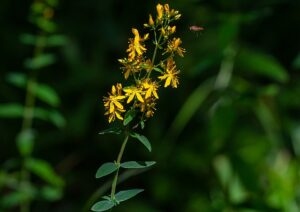How to Grow Agrimony

Growing agrimony requires full sun and well-drained soil. This hardy plant tolerates different soil types and drought conditions. Sow seeds directly in the garden in spring or start indoors in late winter for a head start. It’s a low-maintenance plant that rewards with vibrant blooms. So read on to learn how to grow agrimony.
Choosing the Right Location
Agrimony (Agrimonia) is a plant that thrives in a location that receives full sun to partial shade. Therefore, when planning to grow this plant, it’s essential to choose a site that gets plenty of sunlight throughout the day. This exposure allows the agrimony to develop healthy foliage and produce its characteristic small, yellow flowers. If the location gets some shade, especially in the hottest part of the day, the agrimony can still prosper, but a predominantly sunny spot is most beneficial.
2. Soil Preparation
Agrimony plants prefer well-drained, loamy soil. A balanced soil composition facilitates their optimal growth. The soil pH should ideally be between 6.0 and 7.0. This slightly acidic to neutral pH helps the plants absorb nutrients efficiently. If your soil doesn’t naturally meet these conditions, you may need to amend it. Incorporating organic matter like compost or well-rotted manure can improve the soil structure and fertility. Also, based on the soil test results, you might need to add a balanced fertilizer to provide the necessary nutrients for the agrimony plants’ growth and development.
3. Planting the Seeds
In the spring, you can begin to sow your agrimony seeds directly into the prepared soil. It is important to ensure each seed is spaced approximately 2 feet apart from one another. This spacing allows each plant to have enough room to grow and flourish without competing for resources. Carefully place each seed into a small hole in the soil, then lightly cover it over with additional soil. Always remember to water the freshly sown seeds to encourage germination and root development.
4. Watering
After the agrimony seeds are planted, ensure to water them thoroughly. This initial watering is essential to help the seeds settle into the soil and stimulate germination. Throughout the growing season, maintain an even moisture level in the soil. Agrimony plants are drought-tolerant to some extent, yet they perform best when the soil is consistently moist. Avoid overwatering or creating waterlogged conditions, as this can lead to root rot. Regular, even watering mimics the natural rainfall these plants would typically receive, promoting healthy growth and the development of vibrant, yellow flowers.
5. Routine Care and Maintenance
Regular monitoring of your agrimony plants will help you catch any signs of pests or disease early. Look out for changes in leaf color, holes or chewed edges on the leaves, or a decline in the overall vigor of the plant—these could be signals of a pest invasion or disease. If you notice any unhealthy plants, it’s best to remove them promptly to prevent the issue from spreading to the rest of your crop.
6. Pruning Agrimony Plants
Pruning your agrimony plants should ideally be done in the early spring before the new growth begins. This allows the plant to direct its energy towards creating fresh, healthy shoots and flowers. To prune, start by removing any dead or damaged stems from the previous growing season. Cut these back to the ground, ensuring to make clean, sharp cuts to avoid causing unnecessary stress to the plant. If the plant is overly dense, you can also thin out some of the living stems to improve air circulation and light penetration. Remember, a well-pruned plant is not only healthier but also yields a more abundant and vibrant bloom. Regular pruning is a critical part of agrimony care and should not be overlooked.
7. Size and Color of Agrimony Plants
Agrimony plants are typically quite tall, often growing to heights of 2 to 3 feet, though some varieties can reach up to 5 feet. They feature wiry, upright stems with pinnately compound leaves that are deep green above and silvery below. The plants bloom in the summer, producing slender spikes of tiny, yellow, five-petaled flowers that add a splash of bright color to your garden.

8. Uses of Agrimony in the Garden
Agrimony is versatile and can be planted in various parts of the garden. It’s ideal for borders and meadow gardens, where its tall, slender stems and vibrant flowers can create an eye-catching display. The plant’s height also makes it a suitable choice for the back of flower beds, adding depth and structure. Additionally, agrimony is beneficial to pollinators, attracting bees and butterflies with its bright, nectar-rich flowers. Its seed pods also provide a food source for various bird species. Incorporating agrimony in your garden can thus contribute to boosting local biodiversity.
9. Harvesting and Preserving Agrimony
Harvesting agrimony involves a simple process. During the summer, when the flowers are in full bloom, carefully pick the leaves and flowers with your fingers or use a pair of sharp garden shears. Be gentle to avoid damaging the plant, and always leave enough flowers for the pollinators. After harvesting, you can preserve the agrimony leaves and flowers by drying them. Spread them out in a single layer on a clean, dry cloth or paper and leave them in a dry, well-ventilated area away from direct sunlight. Once they’re completely dry, store them in airtight containers in a cool, dark place.
10. Using Agrimony
Agrimony has a myriad of uses. It can be used to make herbal tea, known for its potential health benefits. Additionally, the dried leaves and flowers can be used in potpourri for a natural and refreshing aroma. Agrimony is also known for its potential medicinal properties and can be used in various home remedies, though you should always consult with a healthcare professional before self-treating with herbs.
Conclusion
Agrimony is a versatile and attractive plant with a multitude of uses. It’s easy to grow, harvest, and preserve, making it an ideal choice for beginner gardeners. Incorporating agrimony in your garden can also help boost local biodiversity by providing food and shelter for wildlife. In addition to its medicinal properties and contributions to local biodiversity, agrimony also has other benefits. For one thing, it makes a great addition to the landscape. Its bold and cheerful yellow flowers bring a vibrant splash of color to any garden. Additionally, agrimony is drought-tolerant and requires very little maintenance—just an occasional pruning to keep it under control. This makes it an easy choice for busy gardeners who don’t have much time for upkeep. Lastly, agrimony has been used in folk medicine for centuries. Its potential health benefits range from easing digestive issues to soothing skin irritations and more. Again, it’s important to consult with a healthcare professional before using agrimony as a home remedy.
For more on growing vegetables and herbs click here.
For infomation on agrimony herb and it medicinal properties click here.


